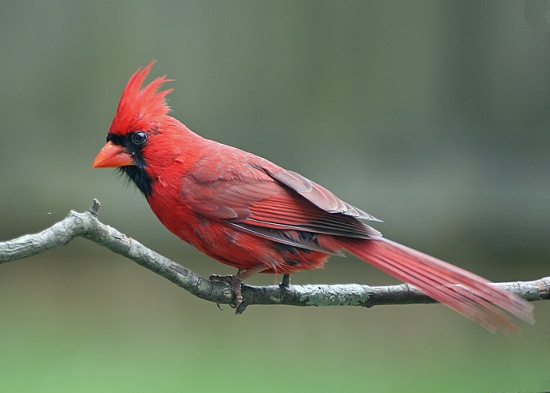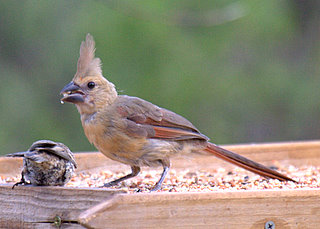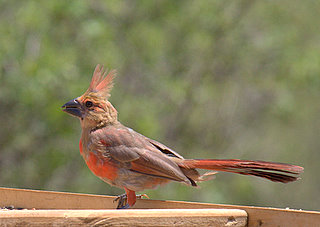| Line 18: | Line 18: | ||
==Distribution== | ==Distribution== | ||
| − | + | [[United States]] | |
| − | |||
| − | |||
==Taxonomy== | ==Taxonomy== | ||
| Line 27: | Line 25: | ||
==Behaviour== | ==Behaviour== | ||
Cardinals feed on a variety of foods including seeds, leaf buds, flowers, berries, and fruit. Up to one-third of its summer diet can be insects. Its winter diet is 90 percent vegetable matter, especially large seeds. Winter flocks can be very large, up to 60 or 70 individuals in areas of abundance. | Cardinals feed on a variety of foods including seeds, leaf buds, flowers, berries, and fruit. Up to one-third of its summer diet can be insects. Its winter diet is 90 percent vegetable matter, especially large seeds. Winter flocks can be very large, up to 60 or 70 individuals in areas of abundance. | ||
| − | Cardinals are noted for their loud, clear whistled songs, often sung from a high treetop song post. Females will counter sing, duetting with males—usually after the males have established territories and before nesting begins. Local variations and accents have been noted in cardinal songs | + | Cardinals are noted for their loud, clear whistled songs, often sung from a high treetop song post. Females will counter sing, duetting with males—usually after the males have established territories and before nesting begins. Local variations and accents have been noted in cardinal songs. |
==External Links== | ==External Links== | ||
*[http://www.birdforum.net/pp_gallery/showgallery.php/cat/all/si/Cardinalis%20cardinalis%20/page/3/sort/4/perpage/12/what/allfields View more images of Northern Cardinal in the gallery] | *[http://www.birdforum.net/pp_gallery/showgallery.php/cat/all/si/Cardinalis%20cardinalis%20/page/3/sort/4/perpage/12/what/allfields View more images of Northern Cardinal in the gallery] | ||
[[Category:Birds]] | [[Category:Birds]] | ||
Revision as of 16:48, 5 November 2007
- Cardinalis cardinalis
Identification
Male All red with black mask and chin. Wings have some gray. Red bill Female Brown overall with some red in wings, face, and tail. Red bill Juvenile Similar to female but bill is dark instead of red. All birds show a crest. Length: 7.75 inches Large, conical bill Crest Long tail Adult male:Bright red plumage, dullest on back and wings Black around base of bill Red bill Adult female:Reddish crest, wings and tail Brownish-gray upperparts Buffy underparts Red bill Juvenile like adult female but has dark bill and crest
Distribution
Taxonomy
Habitat
Typical habitats are thickets and brushy areas, edges and clearings, riparian woodlands, parks, and residential areas.
Behaviour
Cardinals feed on a variety of foods including seeds, leaf buds, flowers, berries, and fruit. Up to one-third of its summer diet can be insects. Its winter diet is 90 percent vegetable matter, especially large seeds. Winter flocks can be very large, up to 60 or 70 individuals in areas of abundance. Cardinals are noted for their loud, clear whistled songs, often sung from a high treetop song post. Females will counter sing, duetting with males—usually after the males have established territories and before nesting begins. Local variations and accents have been noted in cardinal songs.






